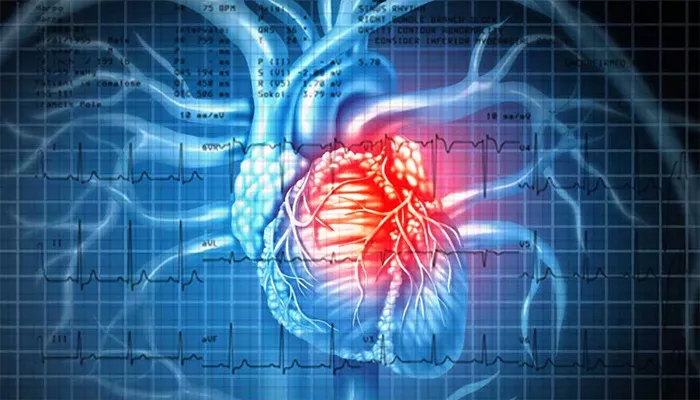Heart attacks, also known as myocardial infarctions, occur when blood flow to a part of the heart is blocked. This blockage can damage heart tissue and disrupt the heart’s normal electrical signaling. As a result, arrhythmias—irregular heartbeats—can develop. Understanding the relationship between heart attacks and arrhythmias is crucial for both prevention and treatment. This article explores the mechanisms by which heart attacks lead to arrhythmias, highlighting the specific reasons behind this serious complication.
SEE ALSO: What Causes Respiratory Sinus Arrhythmia?
The Basics of Heart Function
The heart is a muscular organ responsible for pumping blood throughout the body. It consists of four chambers: two atria and two ventricles. The heart’s rhythm is regulated by electrical impulses generated by specialized cells. These impulses travel through the heart muscle, causing it to contract and pump blood effectively.
When blood flow to the heart muscle is obstructed, as in a heart attack, the affected area can become ischemic, meaning it does not receive enough oxygen. This oxygen deprivation can affect the heart’s electrical system, leading to various types of arrhythmias.
Types of Arrhythmias Post-Heart Attack
Arrhythmias can manifest in different forms following a heart attack.
Common types include:
Ventricular Tachycardia (VT): A fast, abnormal heart rate originating from the ventricles. This can reduce the heart’s efficiency in pumping blood.
Ventricular Fibrillation (VF): A chaotic, ineffective heartbeat that can lead to sudden cardiac arrest if not treated immediately.
Atrial Fibrillation (AF): An irregular and often rapid heart rate that can increase the risk of stroke.
Bradycardia: A slower than normal heart rate that may occur due to the heart’s electrical system being affected by damage.
Mechanisms Linking Heart Attacks And Arrhythmias
Several specific reasons explain how heart attacks lead to arrhythmias:
1. Ischemia
During a heart attack, a portion of the heart muscle becomes ischemic due to the lack of blood flow. Ischemic tissue may become less responsive to electrical impulses, leading to abnormal heart rhythms.
The damaged cells may generate erratic electrical signals, causing the heart to beat irregularly.
2. Electrical Conduction Disruption
The heart’s electrical conduction system can be disrupted by the death of heart muscle cells during a heart attack. The sinoatrial (SA) node, the heart’s natural pacemaker, relies on healthy tissue to function properly. Damage to the heart muscle can interfere with the SA node’s ability to regulate heartbeats, leading to arrhythmias.
3. Scar Tissue Formation
After a heart attack, the damaged tissue often heals by forming scar tissue. This scar tissue does not conduct electricity like healthy heart muscle. As a result, it can create barriers to normal electrical signals, leading to the development of arrhythmias. Scar tissue can disrupt the pathways through which electrical impulses travel, causing them to take unintended routes.
4. Autonomic Nervous System Imbalance
The autonomic nervous system regulates heart rate and rhythm.
During a heart attack, stress responses can activate the sympathetic nervous system, increasing heart rate and potentially leading to arrhythmias. Conversely, damage to the heart may also enhance vagal tone, which can lead to bradycardia or other irregularities.
5. Electrolyte Imbalances
Heart attacks can cause changes in electrolyte levels, such as potassium, calcium, and magnesium. These electrolytes are essential for maintaining normal electrical activity in the heart. An imbalance can alter the heart’s conduction pathways, leading to arrhythmias.
6. Inflammation
Following a heart attack, inflammation can occur within the heart tissue. This inflammatory response may further disrupt the heart’s electrical conduction system, contributing to the development of arrhythmias. Inflammatory cytokines can affect the electrical properties of heart cells, leading to abnormal rhythms.
7. Increased Myocardial Oxygen Demand
After a heart attack, the heart may attempt to compensate for damaged muscle by increasing its workload. This increased demand can lead to further ischemia, exacerbating the risk of arrhythmias. The heart’s attempt to maintain adequate blood flow may result in a vicious cycle of increasing arrhythmia risk.
Risk Factors for Post-Heart Attack Arrhythmias
Several factors can increase the likelihood of developing arrhythmias after a heart attack:
Age: Older individuals may have a higher risk due to age-related changes in the heart.
Pre-existing Heart Conditions: Individuals with a history of heart disease are more likely to experience arrhythmias post-heart attack.
Diabetes: This condition can affect the heart’s health and increase the risk of arrhythmias.
Hypertension: High blood pressure can contribute to heart damage and arrhythmias.
Lifestyle Factors: Smoking, excessive alcohol consumption, and a sedentary lifestyle can also increase risk.
Conclusion
Arrhythmias are a significant concern following a heart attack, arising from a combination of ischemia, electrical conduction disruption, scar tissue formation, autonomic nervous system imbalance, electrolyte imbalances, inflammation, and increased myocardial oxygen demand. Understanding these mechanisms can aid in the prevention and management of arrhythmias in patients recovering from heart attacks. Effective treatment and rehabilitation strategies, including medication, lifestyle changes, and close monitoring, are essential for reducing the risk of arrhythmias and improving overall heart health.
Related topics:


